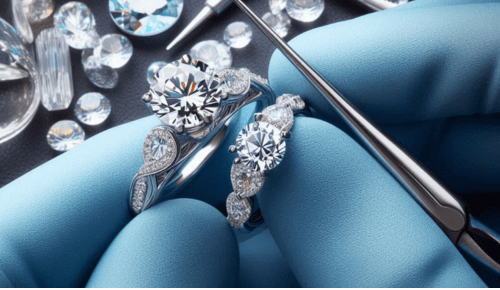Choosing Between White Gold and Platinum for Your Lab Diamond Rings
When shopping for lab diamond rings, one of the most crucial decisions you’ll need to make is choosing between white gold and platinum for the band. Both metals are highly sought after for their stunning appearance and durability, but they offer distinct qualities that can impact your ring’s look, feel, and overall value. Lily Arkwright offers a range of options to help you choose the perfect metal. Understanding these differences is essential for making an informed choice that suits your personal style, budget, and long-term needs.
White gold is a popular choice for engagement rings and wedding bands due to its elegant, silvery-white appearance. It is created by alloying pure gold with other metals such as palladium, nickel, or silver, and then plating the surface with a thin layer of rhodium to enhance its whiteness and shine. Over time, however, the rhodium plating may wear off, requiring periodic re-plating to maintain the shiny look. While white gold offers a similar appearance to platinum at a lower cost, it may require more maintenance to retain its luster.
On the other hand, platinum is a naturally white metal, meaning it doesn’t require rhodium plating. Its rich, lustrous appearance remains consistent throughout the life of the ring, without the need for regular upkeep. Platinum is one of the densest and heaviest precious metals, which contributes to its durability. Because of its resistance to tarnish and wear, platinum is an excellent choice for those seeking a long-lasting ring that can withstand daily wear without losing its appeal.
In terms of appearance, both metals are visually striking, and the choice between them often comes down to personal preference. White gold tends to have a brighter, more reflective finish because of the rhodium plating, while platinum has a softer, more subdued shine. Some individuals prefer the cooler, more polished look of white gold, while others gravitate toward the timeless elegance of platinum’s natural sheen. The subtle differences in appearance may seem small, but they can have a significant impact on the overall aesthetic of the lab diamond ring.
When it comes to durability, platinum is the clear winner. While white gold is sturdy, it is generally softer than platinum, which makes it more prone to scratches and dings over time. Platinum’s resistance to scratching and its ability to maintain its shape make it an ideal choice for those with active lifestyles or individuals who wear their rings every day. Additionally, platinum’s weight adds a sense of substantiality and security to the wearer, making it feel more like a permanent symbol of commitment.
Another important factor to consider is cost. White gold is typically more affordable than platinum, as it is lighter and less expensive to produce. If you are working with a specific budget, white gold may be a more accessible option while still offering the beauty and sophistication of a high-end metal. Platinum, on the other hand, comes at a premium due to its rarity and density. The price difference between the two metals can be significant, so it’s essential to balance your preferences with your financial considerations when choosing between white gold and platinum.
Both white gold and platinum offer exceptional quality and beauty, making them excellent choices for lab diamond rings. Ultimately, the decision will depend on your style, lifestyle, and budget. If you’re looking for a more affordable option that still exudes elegance and shine, white gold may be the right choice for you. However, if you want a durable, low-maintenance, and timeless metal that will last for generations, platinum may be the better option. Whichever you choose, both metals are sure to enhance the brilliance of your lab diamond ring, creating a stunning symbol of love and commitment.

